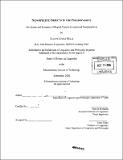| dc.description.abstract | This thesis introduces a special form of pseudopassive that differs from previously discussed forms in that it includes a direct object adjacent to the verb. It is shown that the direct object position in this construction is restricted to NPs that lack D(eterminer)-level projections. As a result, the direct object can only receive a non-specific interpretation, resists certain types of modification, extraction, and scope interactions. Due to its lack of D-level, I argue, the direct object also cannot check the EPP feature on T and therefore cannot raise to subject of the passive sentence. T, then, must probe instead into the PP, agreeing with the PP-object and raising it to its specifier. I posit that the syntactic machinery which allows pseudopassivization is the availability in English of selecting prepositions from the lexicon that are unvalued for tense - as such, these prepositions must depend on the c-commanding verb to value their tense features and in turn assign case to their objects. When the verb itself is unvalued for tense, the PP's nominal object must raise to a higher project to value its tense features (i.e., to be case-licensed); this is the situation in passives, namely in pseudopassives. The solution I argue for draws heavily from the recent research and framework of Pesetsky & Torrego (2004, 2006, 2007). On the semantic side, the direct objects in these pseudopassives are compared to similarly behaving non-specific nominals in Hindi, Chol, Tongan, Inuktitut, Nez Perce, among others (Dayal 2003, Coon to appear, Ball 2005, Wharram 2003, Deal 2007). The researchers who identified such nominals in these languages have referred to them as pseudo-incorporated, and claim that pseudo-incorporated NPs are interpreted not as individuals (type e) but as properties (type <et>). Following their lead, I have coined the term pseudo-incorporated pseudopassive (PIPP) for the special form of pseudopassive that includes these reduced, non-specific direct objects. In order to semantically combine the passive predicate with these non-specific propertytype arguments, I adopt Wharram (2003) and Deal's (2007) proposal for a morpheme, ANTIP, that adjoins to the verb root and yields a property-taking function in place of an individual-taking one. | en_US |
